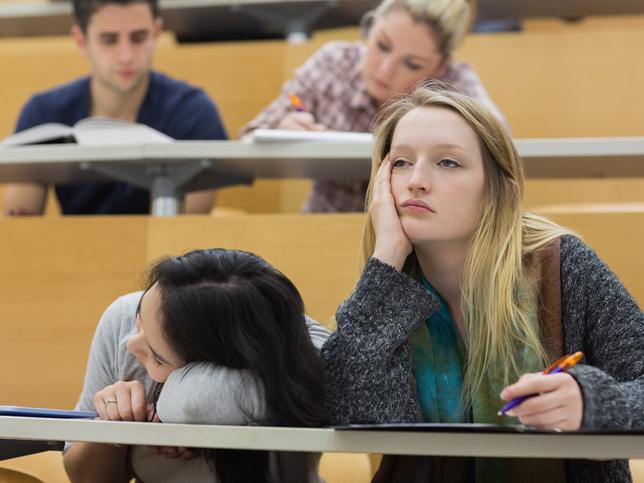
Learning can be an emotional roller coaster: how can we help our students (and ourselves) enjoy the ride?
Emotions can help and hinder learning. These practical, evidence-based strategies can help teachers understand and engage student emotions for better outcomes
Emotions are integral to learning – whether that be the interest or curiosity that sparks learning in the early years of life, the influence of social interactions during adolescence or the satisfaction that can come with career-directed learning and achievement in adulthood. When it comes to learning in higher education, students are often not well prepared for the emotional roller coaster they are about to board. They can experience the highs of positive emotions that come from pursuing a passion, excitement about a learning event, or joy at a pleasing achievement, and they can experience the lows of negative states such as boredom when the topic or experience lacks personal interest, anxiety as they manage assessment deadlines and workloads, or frustration when they are unable to resolve a misunderstanding or learning challenge.
For too long, emotions have been perceived as a “distraction” to cognition in many formal learning environments, including in higher education. Instead, educators and learning designers can draw upon the science of learning to understand and use emotions to promote more effective and engaging learning in diverse courses, contexts and modes.
- Collection: A framework for learning in seven principles
- Spotlight: Creativity in higher education
- How to foster student well-being with online mindfulness training
In this, the first of three articles about how emotions can promote greater student engagement and learning, we explore strategies that help to promote emotional states that facilitate learning and that can smooth the ride for students.
How do emotions affect learning?
The science of learning has confirmed that emotions underpin cognitive processes such as attention, memory, decision-making, problem-solving, executive function, creative thinking and goal-setting. Positive emotions (such as interest, curiosity, wonder and joy) can enhance attention and memory and expand perspectives. Negative emotional states (including anxiety, fear, sadness and anger) can negatively impact on a student’s capacity to engage effectively in a learning experience. Negative affect can also inhibit memory, executive functions and higher order skills such as creativity. Not all experiences of negative emotions are bad for learning, though. Epistemic emotions such as confusion can be powerful for learning (when they are successfully resolved), even though they may feel uncomfortable. Likewise, moderate levels of anxiety, such as those associated with a musical performance, can improve attention, focus and achievement.
Educators and learning designers should understand the valence (positive or negative state) of emotion as well as the role of emotions in student motivation and engagement. Essential for successful learning at any stage of life, motivation and engagement involve cognitive, affective and behavioural dimensions. Understanding what influences emotions in learning contexts, how to optimise emotional states that are conducive to learning and minimise the experience of unhelpful emotions can assist students to engage with their learning experience and enhance their learning outcomes. An understanding of emotions and their role in learning, motivation, engagement and achievement can support the design and delivery of learning experiences that can promote student learning, achievement and sense of connection.
What influences emotions in the classroom?
Students do not leave their emotional selves outside when they enter the classroom. The diverse factors that influence student emotions can include:
- how interested a student is in the topic, subject or course
- how relevant a topic or course is to a student’s goals, aspirations or career path
- how well a student might perceive they are doing or can do in the course
- the perceived difficulty of the course/topic
- whether the student perceives they have access to the internal or external supports needed to meet identified challenges
- the extent to which a topic or course connects to prior knowledge, experience, beliefs or values
- how familiar, safe and comfortable learners feel in the learning environment, be that face to face, online or other modes
- the sense of belonging and connection a learner or group of learners feels in the class, cohort or institution
- the extent to which the higher education experience contributes to a student’s evolving professional identity and sense of self
- external sources such as personal, social, cultural, political or environmental stressors, events, relationships, interests or activities
- physical and mental health
- sleep and nutrition.
Understanding what might be influencing students’ emotional states in relation to classes or courses can be very difficult for an educator to determine and respond to. To further complicate it, the experience of emotions is highly subjective, particularly in a learning context. For example, a challenging learning task may induce stress and anxiety in one student but may motivate and engage another. Therefore, the subjective nature of emotions can make the process of designing emotionally engaging learning experiences a complex and seemingly impossible task for educators.
What can educators do to promote emotional states that facilitate learning?
Here are simple but effective strategies for both large and small cohorts:
- Make explicit the relevance and value of the learning experience: for example, explain how the course content connects to real-world contexts and experiences, or connect the learning experience to the assessment tasks
- Promote opportunities for students to get to know one another (this is important even with smaller groups), so they can build a sense of connection and belonging within the cohort
- Use the social dynamics of these connected groups to promote emotional connection
- Use positive language and body language (such as smiling and being attentive)
- Acknowledge student contributions in class
- Use students’ names
- Draw on the principles of emotional contagion (that emotional states can be shared across a group) and model positive emotions
- Listen to students when they are speaking
- Invite students to share something they have learned from someone else.
Educators and learning designers need to recognise that emotions play a role in how and why students learn, and in student engagement. Emotions drive student interest and motivation and therefore can influence the extent to which students – individually and collectively – engage with course materials and experiences.
By understanding and valuing the role of emotions in learning, we can harness their impact to promote learning, making the roller coaster in the higher education learning journey a more enjoyable ride.
Annemaree Carroll is head of the Science of Learning Research Centre Learning Lab; Stephanie MacMahon is programme director of the Learning Lab; Alexandra Osika is a research assistant in the Learning Lab working in higher education, all at the University of Queensland. The Science of Learning Research Centre Learning Lab at the School of Education at the University of Queensland brings together multidisciplinary researchers and interprofessional partners with the aim of transforming learning across the lifespan.
If you found this interesting and want advice and insight from academics and university staff delivered directly to your inbox each week, sign up for the THE Campus newsletter.




